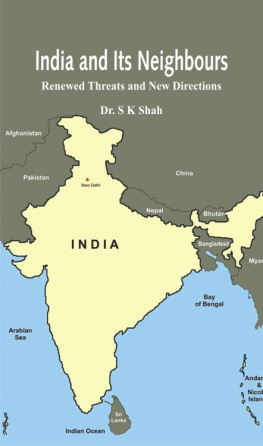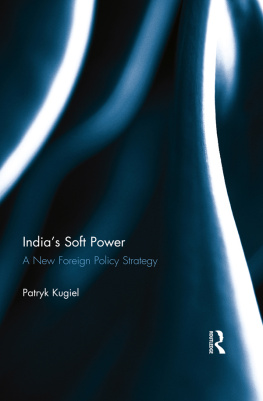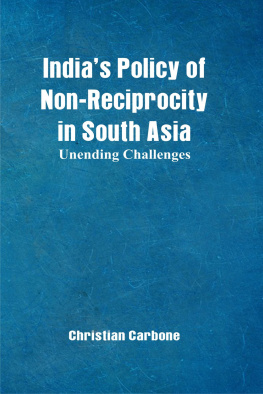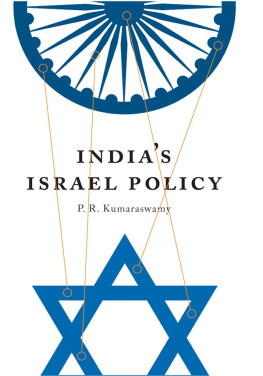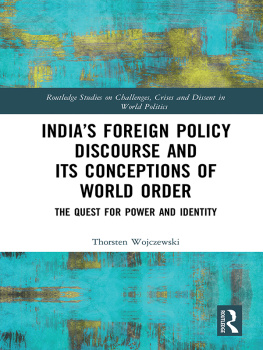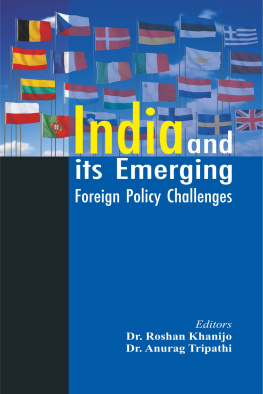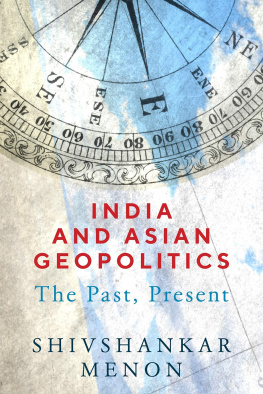India and Its Neighbours
India and Its Neighbours
Renewed Threats and New Directions
Dr. S K Shah
Alpha Editions
Copyright 2017
ISBN : 9789386367501
Design and Setting By
Alpha Editions
email - alphaedis@gmail.com
All rights reserved. No part of this publication may be reproduced, distributed, or transmitted in any form or by means, including photocopying, recording, or other electronic or mechanical methods, without the prior written permission of the publisher.
The views and characters expressed in the book are of the author and his/her imagination and do not represent the views of the Publisher.
Contents
Preface
1. Bilateral, Neighbours and Regional Relations of India
2. Threat Perceptions in India, Pakistan and China
3. India-China Relations and the Re-construction of Strategic Partnerships
4. India and SAARC: Relations and Policy
5. India and Pakistan : Relations, Conflict and Border Problems
6. The Sino-Indian War and Threats
7. Changing Paradigms in India-Nepal Relations
Bibliography
Index
Preface
The changing scenarios in the India's neighbourhood and in the global order over the past decade have made India to take a close look at her national interests. The bipolar world has given way to a non-polar world in which several new powers have emerged. India has to formulate policy options about her foreign and security policies.
Indian analysts, who talk of the Indian sub-continent, wish to keep in mind, in their analyses, the common historical, political, religious and cultural heritage of these three countries. The term sub-continent is used less and less in Pakistan and Bangladesh. The political leadership and the policy-makers in these two countries do not wish to be reminded of this common heritage. Any highlighting of this common heritage by Indian analysts is viewed by them with suspicion as indicating a hidden desire to reverse history and undo the 1947 partition.
India's foreign policy has always regarded the concept of neighbourhood as one of widening concentric circles, around a central axis of historical and cultural commonalities. The guiding principles of India's Foreign Policy have been founded on Panchsheel, pragmatism and pursuit of national interest.
Narendra Modi took the oath of office as India's 14th prime minister. Among his first decisions as head of government - in fact, it was set in motion even before the formal start of his tenure - was an unconventional act of diplomacy: inviting eight foreign leaders of neighbouring countries to attend his inauguration. All the matter is just compiled and edited in nature. Taken from the various sources which are in public domain.
This book contains the fundamental and basic information of the subject.
Editor
Bilateral, Neighbours and Regional Relations of India
Neighbours
Bangladesh
Both states are part of the Indian subcontinent and have had a long common cultural, economic and political history. India played a crucial part in Bangladeshs independence from Pakistan. In recent years India provides co-operation and assistance during annual natural calamities. India is largest exporter to Bangladesh. Most of differences are of sharing water resources between the two countries, such as the Ganges, where Bangladesh accuses India of diverting Ganges water to Calcutta through Farakka Barrage.
Bhutan
Historically,there have been close ties with India. Both countries signed a Friendship treaty in 1949, where India would assist Bhutan in foreign relations. On 8 February 2007, the Indo-Bhutan Friendship Treaty was substantially revised under the Bhutanese King, Jigme Khesar Namgyel Wangchuck. Whereas in the Treaty of 1949 The Government of India undertakes to exercise no interference in the internal administration of Bhutan. On its part the Government of Bhutan agrees to be guided by the advice of the Government of India in regard to its external relations. In the revised treaty it now reads as, In keeping with the abiding ties of close friendship and cooperation between Bhutan and India, the Government of the Kingdom of Bhutan and the Government of the Republic of India shall cooperate closely with each other on issues relating to their national interests. Neither government shall allow the use of its territory for activities harmful to the national security and interest of the other.
The revised treaty also includes in it the preamble Reaffirming their respect for each others independence, sovereignty and territorial integrity, an element that was absent in the earlier version. The Indo-Bhutan Friendship Treaty of 2007 strengthens Bhutans status as an independent and sovereign nation.
Tata Power is building a hydro-electric dam. This dam will greatly develop the Bhutanese economy by providing employment, and by selling electricity to India and fulfilling Indias burgeoning energy needs. Due to this dam Bhutans economy grew 20%, the second highest growth rate in the world.
China
Despite lingering suspicions remaining from the 1962 Sino-Indian War and continuing boundary disputes over Aksai Chin and Arunachal Pradesh, Sino-Indian relations have improved gradually since 1988. Both countries have sought to reduce tensions along the frontier, expand trade and cultural ties, and normalize relations.
A series of high-level visits between the two nations have helped improve relations. In December 1996, PRC President Jiang Zemin visited India during a tour of South Asia. While in New Delhi, he signed with the Indian Prime Minister a series of confidence-building measures for the disputed borders. Sino-Indian relations suffered a brief setback in May 1998 when the Indian Defence minister justified the countrys nuclear tests by citing potential threats from the PRC.
However, in June 1999, during the Kargil crisis, then-External Affairs Minister Jaswant Singh visited Beijing and stated that India did not consider China a threat. By 2001, relations between India and the PRC were on the mend, and the two sides handled the move from Tibet to India of the 17th Karmapa in January 2000 with delicacy and tact. In 2003, India formally recognized Tibet as a part of China, and China recognized Sikkim as a formal part of India in 2004. Since 2004, the economic rise of both China and India has also helped forge closer relations between the two. Sino-Indian trade reached US$36 billion in 2007, making China the single largest trading partner of India. The increasing economic reliance between India and China has also bought the two nations closer politically, with both India and China eager to resolve their boundary dispute.
They have also collaborated on several issues ranging from WTOs Doha round in 2008 to regional free trade agreement. Similar to Indo-US nuclear deal, India and China have also agreed to cooperate in the field of civilian nuclear energy.
However, Chinas economic interests have clashed with those of India. Both the countries are the largest Asian investors in Africa and have competed for control over its large natural resources. India and China agreed to take bilateral trade up to US$100 billion on a recent visit by Wen Jiabao to India.
Afghanistan
Bilateral relations between India and Afghanistan have been traditionally strong and friendly. While India was the only South Asian country to recognize the Soviet-backed Democratic Republic of Afghanistan in the 1980s, its relations were diminished during the Afghan civil wars and the rule of the Islamist Taliban in the 1990s. India aided the overthrow of the Taliban and became the largest regional provider of humanitarian and reconstruction aid.

